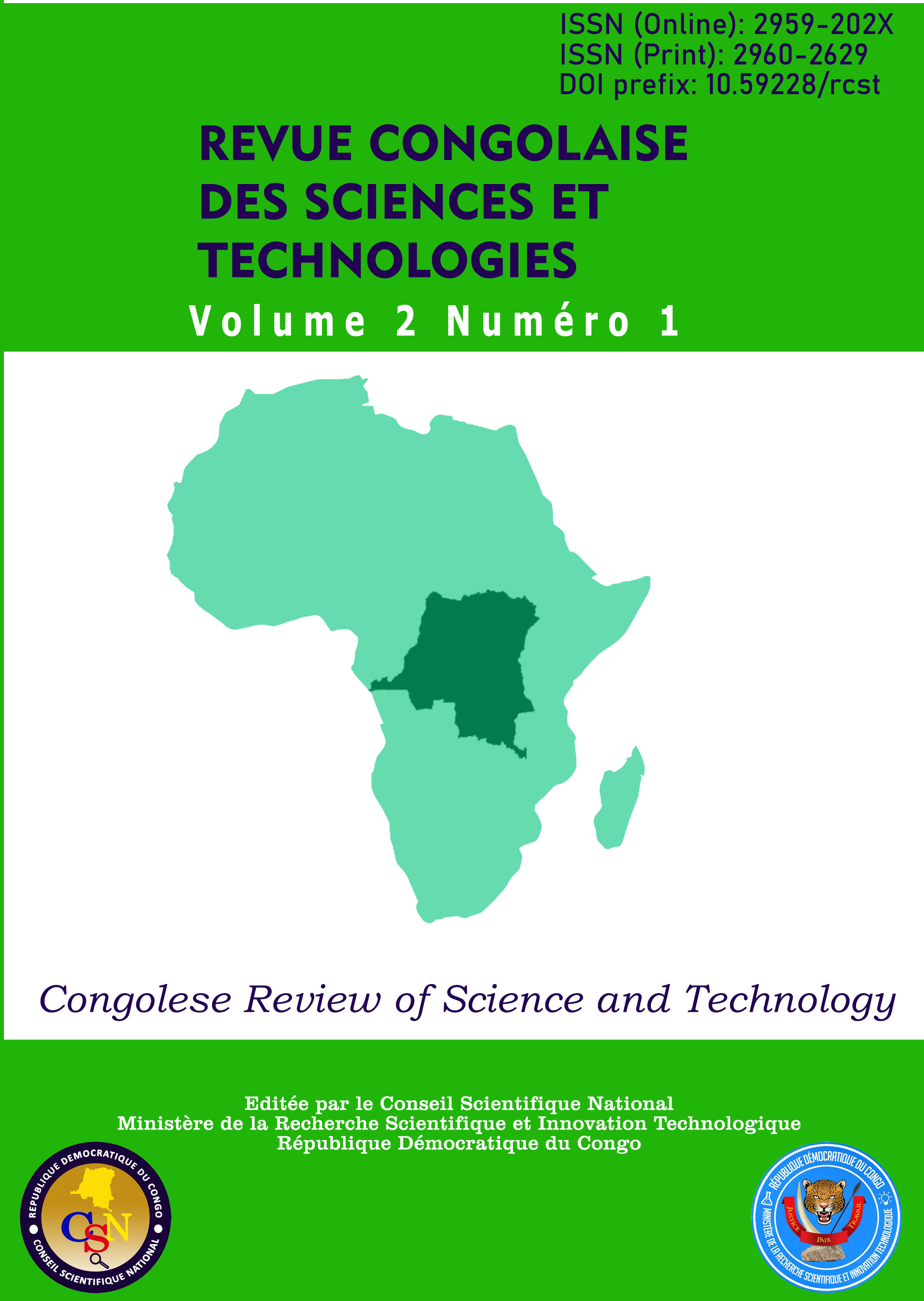Agronomic potential of the second production cycle of banana trees installed in association with forest trees in Kinshasa, DR Congo
Main Article Content
Abstract
The aim of this study is to improve banana production through the sylvo-banana approach. Specifically, this study aims to
evaluate the impact of the banana-tree association on the behavior of banana cultivars in the second production cycle. Five
banana cultivars were intercropped with non-leguminous tree species (NLFS) in a factorial design. After harvesting the
production of the first of the first cycle, the reproductive plants were removed to make room for the successor shoots; and the
evaluation of the behavior of the latter was the object of this study. The results show that the cultivar Nsikumuna performed
better in association with tree species. The cultivar Bubi, on the other hand, performed less well. As for the selected EFANL,
Maesopsis eminii Engl. was the species that stood out. This is because it positively influenced the growth and production of
the banana cultivars more than any other. Further studies are desirable to evaluate the sustainability of a silvo-banana
exploitation based on Nsikumuna and Ndongila cultivars with Maesopsis eminii Engl. as forest species.
Article Details

This work is licensed under a Creative Commons Attribution-NonCommercial-ShareAlike 4.0 International License.
References
Adam, K.A. & Krampah, E., (2005). Gmelina
arborea Roxb. ex Sm. In: Louppe, D., OtengAmoako, A.A. & Brink, M. (Eds). Plant
Resources of Tropical Africa, (pp. 215–221).
Wageningen, CTA Editions.
Adheka, G.J. (2010). Diversité morphologique de
bananiers et bananiers plantains utilisés dans
le bassin du Congo et leur culture en région
forestière du district de la Tshopo dans la
province orientale en république démocratique
du Congo. Inédit.
Asselineau, E. & Domenech, G. (2007). De l’arbre
au sol - Les bois Raméaux Fragmentés.
Rodez, Editions du Rouergue.
Bangata, B.M.J.C., Mobambo, K.N.P. (2022).
Evaluation de la productivité de cinq cultivars de bananiers associés aux légumineuses
arborescentes à Kinshasa, RD Congo. Revue
Marocaine des Sciences Agronomiques et
Vétérinaires 10(4), 461-468.
Barthelemy, D. & Caraglio, Y. (2007). Plant
architecture: a dynamic, multilevel and
comprehensive approach to plant form,
structure and ontogeny. Annals of botany,
(3), 375–407. doi: 10.1093/aob/mcl260
Dhed’a D.B., Moango, A. & Swennen, R. (2011). La
culture des bananiers et bananiers plantains
en R.D. Congo. Support didactique. Kinshasa,
Edition Saint Paul Afrique.
Dupraz, C. & Liagre, F. (2008). Agroforesterie, des
arbres et des cultures. Inédit.
Dupuy, B., & M’Bla Koua, (1993). Les plantations
d’Acajou d’Afrique. Leur sylviculture en forêt
dense humide ivoirienne. Bois & Forets des
Tropiques, 236(236), 25–42.
https://doi.org/10.19182/bft1993.236.a19784
Kasongo, R.K., Verdoodt, A., Kanyankagote, P.,
Baert, G. & Van Ranst, E. (2011). Coffee
waste as an alternative fertilizer with soil
improving properties for sandy soils in humid
tropical environments. Soil Use and
Mangement, 27(2), 94-102.doi:
1111/j.1475-2743.2010.00315.x
Kasulu, V. & Hamel O. (2008). Boisements privés
sur les plateaux de Batéké et terres dégradées
du Bas-Congo pour l'approvisionnement en
bois énergie de l’agglomération de Kinshasa.
Projet de PIN. Inédit.
Ken, F. (2023). Tropical Plants Database. Consulté
le11/02/2023,
sur_https://
.php?id=Lannea+welwitschii>.
Kimpouni, V., (2009). Terminalia superba Engl. &
Diels. In: Lemmens, R.H.M.J., Louppe, D. &
Oteng-Amoako, A.A. (Eds). Plant Resources
of Tropical Africa, (pp.474–492).
Wageningen, CTA Editions.
Kwa, M. & Temple, L. (2019). Le bananier plantain:
Enjeux socioéconomiques et techniques,
expériences en Afrique intertropicale.
Versailles, Éditions Quæ.
Lassoudière A., (2007). Le bananier et sa culture.
Versailles, Editions Quae.
Lassois, L., Busogoro, J. & Jijakli, H. (2009). La
banane : de son origine à sacommercialisation. Biotechnol. Agron. Soc.
Environ, 20(4), 575-586.
Mallet, B. & Saint Amand, D.J. (1981). Mise en
évidence d’un effet inhibiteur des racines de
Terminalia ivorensis sur le développement de
jeunes plants de la famille des combrétacées.
Paris, OSTOM.
Meunier, Q. & Lassois, J.L. (2011). Guide de
plantation et de conduite d’une bananeraie
agroforestière en mileu rural au Gabon.
Projet : Développement d’Alternatives
Communautaires à l’Exploitation Forestières,
seconde phase (DACEFI-2). Inédit.
Nsombo, M.B. (2016). Evolution des nutriments et
du carbone organique du sol dans le système
agroforestier du plateau des Batéké en
République Démocratique du Congo. [Thèse
de Doctorat], Université de Kinshasa, 198
pages.
Orwa, C., Mutua, A., Kindt, R., Jamnadass, R.,
Anthony, S. (2009). Agroforestree Database: a
tree reference and selection guide version 4.0.
Consulté le 11/02/2023, sur
http://worldagroforestry.org/output/agroforestr
ee-database
SENASEM. (2012). Catalogue variétal des cultures
vivrières : Maïs, Riz, Haricot, Arachide, Soja,
Niébé, Manioc, Patate douce, Pomme de terre
et Bananier. Projet CTB/MINAGRI “APPUI
AU SECTEUR SEMENCIER”. Inédit.
SENASEM. (2019). Catalogue national variétal des
cultures vivrières. Répertoire des variétés
homologuées de plantes à racines, tubercules
et du bananier. Inédit.
Soltner, D. (2016). Agroécologie : guide de la
nouvelle agriculture - Sans labour, avec
couverts, légumineuses et rotations. Sciences
Techniques Agricoles, Bressuire.

